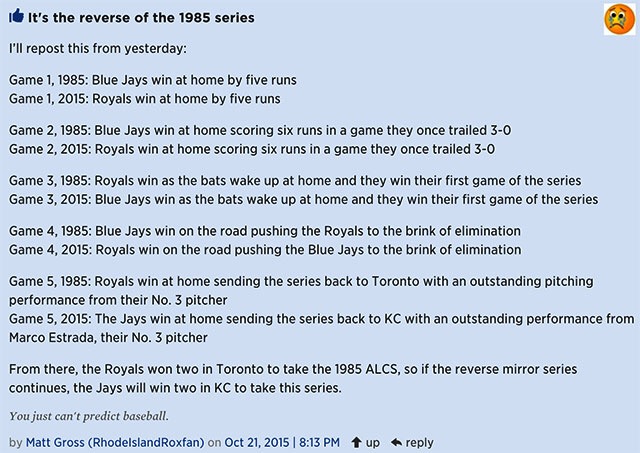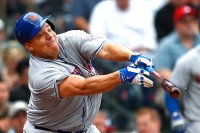R.A. Dickey
The first real playoff team Terry Collins managed with the Mets was in his first season with the team. It is hard to believe now, but that team was full of players that are now members, if not significant contributors, to teams that reached the postseason this year:
- Josh Thole – Toronto Blue Jays (not on the ALDS roster)
- Daniel Murphy – Washington Nationals
- Justin Turner – Los Angeles Dodgers
- David Wright – New York Mets (injured; not on the Wild Card Game roster)
- Jose Reyes – New York Mets
- Angel Pagan – San Francisco Giants
- Carlos Beltran – Texas Rangers
- Lucas Duda – New York Mets (injured; not on the Wild Card Game roster)
- R.A. Dickey – Toronto Blue Jays (not on the ALDS roster)
- Jon Niese – New York Mets (injured; not on the Wild Card Game roster)
Reading the names on that list, the two that immediately jump off the page are Murphy and Turner. They jump off the page for a myriad of reasons. The first reason is the two players are currently facing off against one another in the NLDS between the Dodgers and the Nationals. The series is tied at 1-1 in large part because Turner and Murphy have continued to be terrific postseason player.
Last year, Turner hit .526/.550/.842 with six doubles and four RBI against the Mets in the NLDS last year. Overall, in Turner’s postseason career, he is a .500/.538/.875 hitter with six doubles, one homer, and six RBI.
Murphy was the bat that helped carried the Mets to the World Series last year. In consecutive games, he hit homers off of Clayton Kershaw, Zack Greinke, Jon Lester, Jake Arrieta, and Kyle Hendricks. He would also homer off Fernando Rodney in what was a stretch of six straight games with a home run. In addtion to the homers, Murphy’s going from first to third on a walk in Game Five of the NLDS helped changed the complexion of that game. Additionally, up until the World Series, he had played exceptional defense (which admittedly is a rarity for him). So far in the NLDS, Murphy is 4-6 with a walk and two RBI. The first of the two RBI was the go-ahead RBI in Game 2 of the NLDS.
Between Turner and Murphy, the Mets had at one time two second baseman who have established themselves to be extraordinarily clutch and terrific postseason players. They were also two players the Mets were eager to replace.
Turner was surprisingly non-tendered a contract after a 2013 season where he seemed to solidify himself as a utility or platoon player (at a minimum). Instead, the Mets let him go with rumors circulating that he was a me-first player that didn’t hustle. He was also characterized as a player that wasn’t progressing because he liked the night scene a little too much. He would go to Los Angeles and blossom as a player. The Mets internal replacement? Eric Campbell.
When Murphy became a free agent, the Mets first aggressively pursued Ben Zobrist. After failing to land him, the Mets quickly moved to trade for Neil Walker. At no time did the Mets even make Murphy an offer. Unlike Turner, Walker was an actual replacement with Walker having a great year for the Mets before needing season ending back surgery. However, despite how good Walker’s year was, he still wasn’t anywhere near was good as Murphy was for the Nationals.
It should never have come as a surprise that both of these players were gone because the Mets, under Sandy Alderson’s reign as General Manager, never really wanted either player. If you go back to that 2011 season, the Opening Day second baseman was Rule 5 Draft pick, Brad Emaus. After a couple of weeks of him struggling, the Mets moved on and finally went to Murphy and Turner at second base. Murphy would get the bulk of the playing time there until Ike Davis‘ ankle injury that allowed them to play side-by-side. With Davis’ healing up and being ready for the 2012 season, the Mets proceeded with Murphy as the second baseman and Turner as the utility player. As we know, that lasted just two year.
Ultimately, the Mets made the postseason this year without either player. And yes, both players got their first chance with the Mets. Quite possibly, neither player would be in the position they are in now without the Mets giving them a chance to prove they are major league players. However, the Mets also made clear they didn’t want either player starting all the way back in 2011 when they anointed Emaus the everyday second baseman. Eventually, the Mets would get their chance to move on, and they took advantage of that opportunity.
With that, Murphy and Turner are in the NLDS after the Mets lost the Wild Card Game with T.J. Rivera starting at second base. One of those two will be in the NLCS with a chance to go to the World Series, a position the Mets thought they were going to be in as the season started. With all that in mind, it begs the question: how much differently would the Mets season have gone if they had kept either Turner or Murphy?
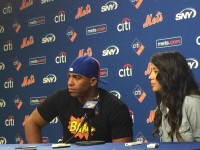
Earlier this offseason, Commissioner Rob Manfred came out against opt out clauses. His stance is important because traditionally the Wilpon family has adhered to the Commissioner’s requests and recommendations. They did so even if it could have possibly prevented the Mets from getting a better player.
I was reminded of that again when I saw the video from the Mets meeting with season ticket holders. Essentially, the Mets appeared to once again be falling lock step with the Commissioner’s office on an issue that would only harm the Mets ability to obtain the better players. Well, now with all the Yoenis Cespedes drama, it appears that may be changing:
Sources: Mets, Cespedes discussing an opt-out clause after the 1st year of a three-year deal. Would allow him to test market again Fall '16.
— Buster Olney (@Buster_ESPN) January 22, 2016
Or is it? We all read Andy Martino’s New York Daily News article about the Winter Meetings. We saw in that article how the Mets attempt to manipulate the media to curry fan favor and/or attempt to remove some heat off of them. The key passage is:
My first scoop came in late November, when some media outlets were reporting that Dickey was seeking a five-year deal. Dickey called me one day, angry, insisting he only wanted three. He believed the Mets were leaking misinformation to make him appear greedy. I didn’t know anything about that, but was more than happy to relay his take. I got the story, and he got his perspective in the paper.
*************
One team official, very late at night, screamed at me, “I don’t know what R.A. is telling you, but he needs to step aside and let his agent handle this.
I look at all of this, and I wonder if the Mets are truly going to offer an opt out clause. We know the Mets previous attempts to change public perception on Cespedes failed. Mets fans don’t want to pass on him because he smokes cigarettes. No, they still want him to return. Further complicating the matter is the fact that Cespedes loved being a Met. That means the Mets need to act and act fast. Judging by Buster Olney’s Tweet, it appears they are.
However, I don’t know how plausible it is the Mets would offer an opt out clause. If the leak came from the Mets, it may just mean they want to placate their fan base that they really tried to land Cespedes on a reasonable deal, but he passed anyway. It might have been leaked by Cespedes’ agents to try to get Washington to bid against themselves. What I do know is that the Mets going against the Commissioner’s Office on an issue is uncharacteristic of them. I hope this is the time it happens, but based on past history, I doubt it.
Until I see Cespedes at a press conference putting his #52 jersey back on, I’m going to assume the Mets offer to Cespedes is three years with an opt out after the third year.
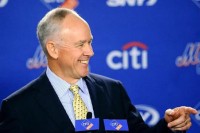
Here’s a question for you. If you had a GM that gave a bad contract to a 35 year old, forfeiting a pick in the process, and depleted it’s farm system of its top end starting pitching prospects for rentals, what would you call that GM? Apparently, you call Sandy Alderson the Executive of the Year.
Before proceeding, I’d like to note Alderson has generally done a good job with the Mets. The R.A. Dickey trade was a stroke of genius. However, that happened three years ago, and this is a 2015 award.
Alderson made two major league free agent signings for the 2015 season. The first was Michael Cuddyer. It was immediately panned by everyone. Alderson was out-maneuvered there by the Rockies of all organizations. With the Mets all but declaring they were signing David Wright‘s friend, the Rockies gave Cuddyer a qualifying offer. The Mets then gave Cuddyer a two year $21 million contract. Cuddyer was hurt, and he regressed as 35 year old players do. He’s now a $12.5 million bench player.
The other free agent deal was John Mayberry, Jr. Mayberry hit .164/.227/.318. He was released at the end of July. Overall, Alderson’s free agent acquisitions were complete busts.
His trades weren’t much better. Do you realize for a team touted with organizational starting pitching depth, Alderson depleted much of it. He traded eight minor league arms in total. For all the pitchers that were traded, Addison Reed is the only player the Mets could keep in 2016. By the way, Reed is a non-tender candidate.
Yes, the Mets made the World Series. They also lost it. For all the moves and sacrificing the future, the Mets still fell short. Further, it does not appear the moves generated enough revenue to sufficiently increase payroll. In the end, the Mets have up two big pitching prospects for rentals. If you’re saying it was worth it, I ask you if John Smoltz was worth it?
In 1987, Smoltz was traded for Doyle Alexander. Alexander went 9-0 with a 1.53 ERA for the Tigers. His fantastic run certainly mirrors the run Yoenis Cespedes had this year. Like the Mets, the Tigers won their division. Like the Mets, the Tigers didn’t win the World Series. The Tigers lost out on a Hall of Fame career. Time will only tell with Michael Fulmer. However, we do know he’s a highly rated prospect the Tigers believe can contribute very soon.
It’s the reason I said it was a bad trade from the beginning. It’s even worse when you consider the Tigers had to trade Cespedes because they were about to lose him for nothing.
Then there’s the issue of giving up another well regarded prospect in Casey Meisner for Tyler Clippard. Clippard was a rental. Yes, Clippard was terrific early on with the Mets, and he helped the Mets win the division. Addison Reed was even better, and the Mets obtained him for much less. Again, this was a bad trade.
No, Alderson won this award for his earlier work and the system built by Omar Minaya. Alderson weakened the farm system in 2015, and he may now need to trade away major league talent rather than minor leaguers to improve the team in 2016. After all his moves, the Mets still don’t have a shortstop. There may also be new holes in center and at second.
Alderson has had a good run here, but he was not good in 2015. He certainly wasn’t the best executive in 2015. Unfortunately, this should bear out in the oncoming years.

Believe it or not, the Mets have actually made two moves this offseason. Both were minor league deals. The first was to utility man Ty Kelly. The second was to Stolmy Pimentel. How will they fare? Who knows?
That’s the thing. You never quite know what to expect when you bring a player in on a minor league deal. Sometimes it’s a veteran just looking for one last shot. It can be a young player just looking to get an opportunity in another organization. Ultimately, these are players that just want a job, and they’re going to give it everything they have because if they don’t, their career might be over.
Mets fans and the organization need not look any further than R.A. Dickey. When Dickey signed the deal he was coming off a then career year that him have a 4.62 ERA and 1.617 WHIP in 35 games (only one start). There was no reason to believe the signing would amount to anything more than minor league depth even if knuckleballers tend to figure things out later than more “conventional” starting pitchers. He came to it even later as an adjustment because he was born without a UCL.
Well, you know the rest. He went 39-28 as a Met with a 2.95 ERA and a 1.150 WHIP. In 2012, he was an All Star and won the Cy Young Award going 20-6 with a 2.73 ERA and a 1.053 WHIP. Because of that year, and the fact the Mets still had him under contract for another year, the Mets made perhaps the best trade in franchise history acquiring Travis d’Arnaud and Noah Syndergaard along with Wuilmer Becerra and John Buck.
Speaking of John Buck, he would be traded by the Mets the following year along with Marlon Byrd. Byrd was also signed to a minor league deal. When these two were traded together, the Mets acquired Vic Black and Dilson Herrera. Black was effective did the Mets out of the bullpen for a year and a half before he was injured. Herrera is the second baseman of the future.
Now, there are a million minor league deals that don’t amount to anything. However, those players are released in Spring Training or spend the year in the minors. You don’t spend much money to acquire them, so it’s not a big deal. This happens in the vast majority of signings.
Still, there are always needles like Dickey and Byrd in the free agent haystack. If you’re able to find them you can turn your franchise around. Now, it’s not likely that either Kelly or Pimentel will make that type of contribution. If they make any positive contribution, the signing is a homerun because nothing is really expected from them. The bar for success is very low, but the sky’s the limit.
It’s why I love minor league deals.

There are times when something is so obvious and compelling that it just had to happen. Right? This year it seems like the Mets and Blue Jays are destined to meet in the World Series. Here’s why:
1985 ALCS
Did you ever see those Abraham Lincoln-JFK assassination similarities lists? On face value, it’s eery, but at the end of the day, they’re an amazing set of coincidences. It reminds me of the 1985 and the 2015 ALCS:
The players are all different. The front offices and managers are different, and yet, so far, the 2015 ALCS is following a similar script. If this is omen rather than coincidence, the Blue Jays win.
The Daniel Murphy Factor
By and large, the NL Cy Young voting is predicted to have Zack Greinke–Clayton Kershaw–Jake Arrieta finish 1-3 in some order. Daniel Murphy has homered off of all of them. Between the Royals and the Blue Jays, there is only one Cy Young candidate: David Price.
With the way Murphy has been playing this Murphtober, doesn’t it seem like he’s destined to homer off of another Cy Young caliber pitcher?
Referendum on the R.A. Dickey Trade
Look, no matter how you slice or dice it, the R.A. Dickey trade has been enormously successful for the Mets. Two of the biggest parts of this Mets team have been Noah Syndergaard and Travis d’Arnaud. That also doesn’t include Wullmer Becerra, who is starting to become a real prospect.
However, for the Blue Jays, the trade was always about winning the World Series. It doesn’t matter is he’s the fourth starter. It doesn’t matter if he hasn’t pitched well in the playoffs. It doesn’t matter if Thor is better now. All that matters now is if the Blue Jays win the World Series.
If they do meet up, it’ll be a great story. Just ask Dickey:
Dickey: “What a script… If I could face Syndergaard in Game 7, wouldn’t that be something? … Great narrative.”
— Jesse Spector (@jessespector) October 19, 2015
Conclusion
Now that I’ve wasted all that time explaining why it’ll happen, we now know the Royals will win Game 6 or 7. It doesn’t matter to me who the Mets face so long as they win the World Series.
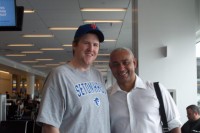
Look, this is Sandy Alderson’s team. He decided to keep the players he kept and trade the players he traded. He pulled off the trades and signed the free agents. However, he was able to do a lot of what he did because he was left with good players after Omar Minaya was terminated.
Here are the players in the 40 man roster who have a link to Omar Minaya (asterisked players are players obtained with players combined by Minaya and Alderson):
Jerry Blevins – obtained for 2010 draft pick Matt den Dekker.
Eric Campbell – 2008 draft pick.
Darrell Ceciliani – 2009 draft pick.
Travis d’Arnaud – part of the R.A. Dickey trade. Dickey was a free agent signing. Josh Thole was a 2005 draft pick. Mike Nickeas was initially obtained by trade in 2006.
Jacob deGrom – 2010 draft pick.
Lucas Duda – 2007 draft pick.
Jeurys Familia – 2007 amateur free agent signing.
Wilmer Flores – 2007 amateur free agent signing.
Erik Goeddel – 2010 draft pick.
Matt Harvey – 2010 draft pick
Dilson Herrera* – part of Marlon Byrd/John Buck trade. Buck was part of the Dickey trade (see d’Arnaud).
Juan Lagares – 2006 amateur free agent signing.
Steven Matz – 2009 draft pick.
Jenrry Mejia – 2007 amateur free agent signing.
Akeel Morris -2010 draft pick.
Daniel Murphy – 2006 draft pick.
Bobby Parnell – 2005 draft pick.
Addison Reed* – obtained in exchange for Matt Koch and Miller Diaz (signed by Mets in 2009).
Hansel Robles – 2008 amateur free agent.
Noah Syndergaard – part of Dickey trade (see d’Arnaud).
Ruben Tejada – 2006 amateur free agent.
Again, these players are in the roster because Alderson kept them. The decision of who to keep and trade is important. That is what makes them Alderson’s players and team. Additionally, while It was Alderson that hired Terry Collins, it was Minaya who brought him into the Mets organization.
However, it is important to truly acknowledge Minaya’s role, especially when he has been unfairlyand wrongly marginalized.
You see I was on the same Jet Blue flight as Omar Minaya. The photo with this post was Minaya and me in the terminal before the flight. He was accessible to Mets fans who wanted to shake his hand and take a picture. No one, and I mean no one, had the “courage” to mock him on the flight.
Additionally, this should dispel the notion that Minaya left the Mets with a depleted farm system. On the contrary, he built a strong farm system that helped make up this team. Minaya had his faults, and he probably deserved to be fired when he was. That doesn’t mean we should ignore his work.
It doesn’t mean that we shouldn’t extend our gratitude to him for what he left behind.

Even though the Mets lost, the Mets Magic Number is now 6 because the Nationals lost to the Orioles. With the Mets having two Rule 5 picks pitching in a game, and both of the Mets young catchers getting into the game, I thought the best choice for magic number 6 would be Kelly Shoppach:
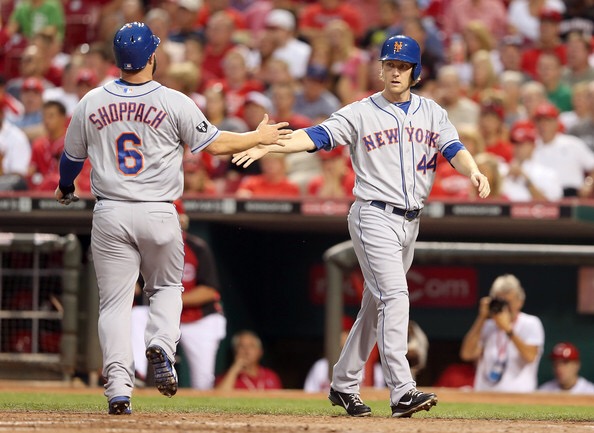
In 2012, the 74-88 Mets traded for the impending free agent Shoppach for a player to be named later. The idea was to get a good look at him to see if the team wanted to re-sign him and/or to get him to work with Josh Thole. Neither one would be back.
Shoppach only hit .203/.276/.342 in 28 games. His play did not inspire the Mets to re-sign him. Thole would be moved in the famed R.A. Dickey trade that netted the Mets 2015 cornerstones, Noah Syndergaard and Travis d’Arnaud.
The player to be named in the Shoppach deal was Pedro Beato, a former Rule 5 draft pick like Sean Gilmartin is this year. We did learn this year the player to be named later was almost Jacob deGrom, which would’ve been disastrous. Note, Sandy Alderson was reported to be alright with trading deGrom at the time until one of his advisors warned him not to make the deal.
But I digress. The seeds of the 2015 Mets were laid in the 2012 offseason. Much of the way the roster is currently constituted has to do with the Shoppach trade and his faired as a Met. If he succeeded, it’s possible he stays, and who knows what happens with d’Arnaud from there? Maybe nothing changes? Maybe Shoppach isn’t as effective a mentor as John Buck. My doctor won’t let me address the deGrom possibilities.
So as the Shoppach trade arguably set the wheels in motion, let’s offer a hat tip to Magic Man Number 6 Kelly Shoppach.
